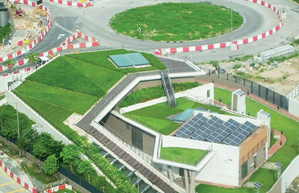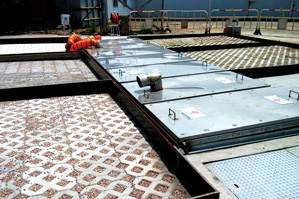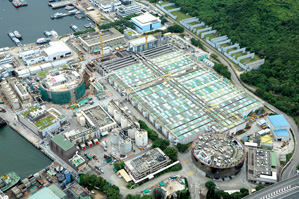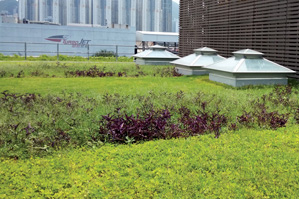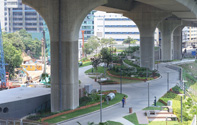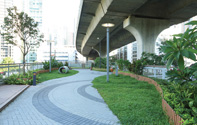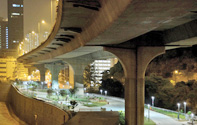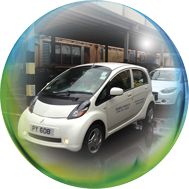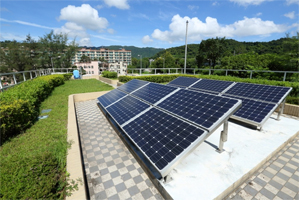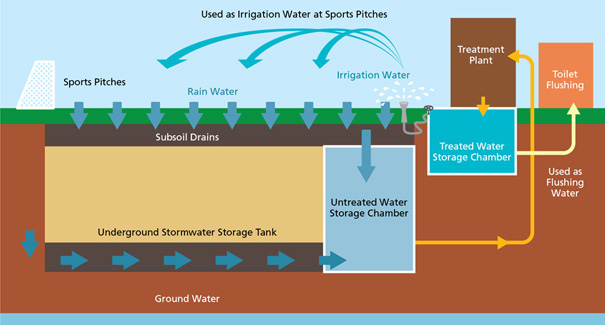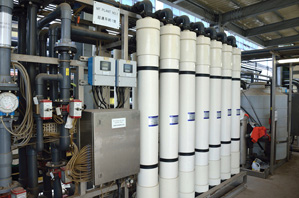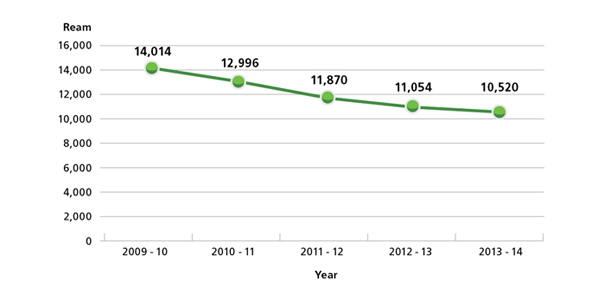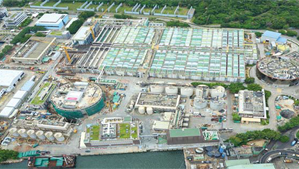Enhancing the environmental performance of our territory-wide facilities is a crucial part of the environmental management strategy. Apart from this, we also engage our staff and suppliers to protect the environment in various ways, such as promoting green culture and green procurement.
Greening and Enhancing Ecology
While planning for new drainage facilities or renovating existing facilities, DSD seizes opportunities to introduce various green features, including green roofs. In 2013-14, we have completed over 4,900 square metres roof greening works for nine facilities, and planted more than 2,100 trees and 320,000 shrubs.
Some of the Green Roofs Recently Completed
Sustainable Initiatives in Stonecutters Island Sewage Treatment Works' Upgrading
The following initiatives are being implemented at SCISTW to establish good examples for the industry.
Drain Responsibly - Introducing Sustainable Drainage Systems
Elements of sustainable drainage systems, such as the provision of bioswale, rain garden, permeable pavement, have been introduced to minimise the impact of excessive runoff.
Build Sustainably - Undertaking BEAM Plus Assessment
The Administration Building of SCISTW is undergoing the Building Environmental Assessment Method (BEAM) Plus Assessment to assess its building performance and to explore ways for improvement through reducing carbon footprint during both construction and operation phases. This will also establish a model of “build sustainably” for other Sewage Treatment Works (STW) to follow suit.
Plant Smartly - Applying Soft Landscaping in Congested Environment
SCISTW is a congested and busy STW with multiple machinery operation and heavy vehicular traffic every day. Greening within SCISTW is hence no easy task and the success has demonstrated DSD’s commitment to sustainability. In the previous year, a total of 1,500 square metres of green roof have been constructed at SCISTW.
Greening Works at Butterfly Valley Road Pet Garden
Opened in March 2014, the Butterfly Valley Road Pet Garden was an example of successful collaboration between DSD, the Leisure and Cultural Services Department and Sham Shui Po District Council in enhancing the local living environment.
The 7,000 square metres pet garden was built on top of the stilling basin of LCKDT and beneath the viaduct of Tsing Sha Highway. This single piece of land serves the multi-purpose of flood prevention, transportation and recreation at the same time. To preserve water resources, the rainwater collected in LCKDT will be used, upon suitable treatment, for nonpotable uses such as for toilet flushing, irrigation and general cleansing within the pet garden, as well as for street cleansing by the Food and Environmental Hygiene Department in Sham Shui Po district.
The pet garden was planted with 75 trees and more than 50,000 shrubs/ groundcovers on 600 square metres of lawn areas.
Energy Management and Emissions Control
Conducting Carbon Audit
We conducted carbon audits for STWs in Sha Tau Kok, Sha Tin, Shek Wu Hui, Stanley, Stonecutters Island and Tai Po this year. Looking forward, we are planning to extend the scope of carbon audits and carbon emission reduction measures to other STW and construction works. We will strive to reduce our carbon footprint and to operate in a more environmentally friendly manner.
Use of Electric Vehicles
Electric vehicles (EVs) are powered by batteries without involving any combustion process. They have zero emission and help improve roadside air quality in Hong Kong. As at March 2014, DSD has engaged ten EVs and their average daily mileage was about 500 kilometres. We target to promote the wider use of EVs in future.
Implementing Various Energy Saving Measures
We have made steady progress in energy saving and emission reduction in our city-wide operation. DSD has saved more than 11.6 million kilowatt-hours of electricity over the past seven years, through measures including optimisation of sewage treatment processes, use of combined heat and power (CHP) plants at various sewage treatment works, and use of high-efficiency pump motors in sewage treatment facilities.
In 2013-14, our performance in energy saving was promising. In particular, the optimisation of aeration system and co-settling at Shatin STW and the optimisation of operation of centrifuges at SCISTW were among the largest contributors.
Use of Renewable Energy
Solar Energy
We have installed large-scale photovoltaic (PV) systems supplying electricity to the equipment at some of our major facilities. The total capacity and annual electricity output of the PV panels were about 121 kilowatts and 104,000 kilowatt-hours respectively. In the coming two years, we plan to install PV panels in nine other sewage treatment facilities at a total capacity of 891 kilowatts.
Energy from Biogas
We have installed CHP generators and micro-turbine systems in our facilities for generation of renewable energy using biogas produced from the sewage treatment process. In 2013-14, we have completed installation of new CHP generators in Sha Tin and Tai Po STW (total capacity at 3,600 kilowatts), and micro-turbine in Yuen Long STW (capacity at 30 kilowatts). The total amount of electricity generated from biogas in 2013-14 was about 27 million kilowatt-hours.
Resources Conservation
Happy Valley Underground Stormwater Storage Scheme - Water Harvesting System
HVUSSS being carried out within the Happy Valley Recreation Ground provides an opportunity for installing a Water Harvesting System (WHS) to collect groundwater, excessive irrigation water and rainwater for reuse in irrigation and toilet flushing upon suitable treatment. The WHS, upon commission, will save a considerable amount of fresh water supply.
Water Reclamation in Sewage Treatment Works
Water reclamation is one of the key initiatives under the Total Water Management Strategy. It refers to the use of reclaimed water to replace high quality fresh water used for non-potable purposes. Reuse of treated effluent, grey water recycling and rainwater harvesting are examples of water reclamation. In 2013-14, the daily production use of reclaimed water by DSD was about 1,200 cubic metres. The new water reclamation facility of Tai Po STW was commissioned in December 2013, further increasing the production of reclaimed water.
Green Procurement and Green Office
DSD has actively supported the Government’s initiatives on green procurement. In 2013-14, we have purchased a wide variety of products in accordance with the green procurement specification. These products ranged from electrical appliances, such as computers, copying machines, printers, electric fans and refrigerators, to office consumables, including recycled paper, correction tapes, pencils, rechargeable batteries, toilet paper and garbage bags.
In addition to implementing guidelines on reducing paper use, we encourage our staff to reuse envelopes. We have also set up recycling stations to collect cartridge toners, rechargeable batteries, paper, plastic and metal containers.
With the fast development of wireless communication technology, we have introduced a “paperless meeting” system, using electronic devices such as tablet computers and notebooks for presentations and discussions at meetings. About 300 paperless meetings were conducted in 2013-14 with more than 2,700 documents circulated and viewed through this system.
Total Paper Consumption (Ream)
Odour Management
Odour Management for Harbour Area Treatment Scheme
During the design stage of HATS Stage 2A, an odour management plan was formulated for Stonecutters Island Sewage Treatment Works which recommended all major existing and planned odour-emitting facilities, to be self-contained and deodourised with a view to eliminating potential odour nuisance.
Below are some of the odour control measures that have been implemented or are being implemented under HATS Stage 2A:
- The sedimentation tanks have been covered since June 2012, and the odourous gas is now extracted and transferred to the biotrickling filters for deodourisation.
- The sludge dewatering facility has adopted chemical scrubber as the prime deodourisation technology.
- At flow chambers where the chance of odour emission is relatively low, a passive approach of containment with pipe work connected to activated carbon deodourisation units has been adopted.








